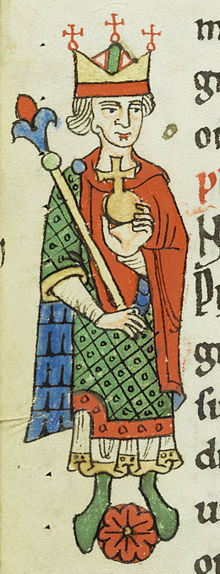Philip of Swabia
| Philip of Swabia | |
|---|---|

Philip of Swabia depicted in a medieval manuscript (about 1200)
|
|
| King of Germany (King of the Romans) | |
| Reign | 8 March 1198 – 21 June 1208 |
| Coronation | 8 September 1198, Mainz |
| Predecessor | Henry VI |
| Successor | Otto IV |
| Duke of Swabia | |
| Reign | 15 August 1196 – 21 June 1208 |
| Predecessor | Conrad II |
| Successor | Frederick IV |
| Born | February/March 1177 Pavia, Italy |
| Died | 21 June 1208 Bamberg, Franconia, Germany |
| Burial | Speyer Cathedral |
| Spouse | Irene Angelina |
| Issue |
Beatrix, Holy Roman Empress Maria, Duchess of Brabant Kunigunde, Queen of Bohemia Elisabeth, Queen of Castile |
| House | Hohenstaufen |
| Father | Frederick I, Holy Roman Emperor |
| Mother | Beatrice I, Countess of Burgundy |
| Religion | Roman Catholic |
Philip of Swabia (February/March 1177 – 21 June 1208) was a prince of the House of Hohenstaufen and King of Germany from 1198 to 1208. In the long-time struggle for the German throne upon the death of Emperor Henry VI between the Hohenstaufen and Welf dynasties, he was the first German king to be assassinated.
Philip was born in or near Pavia in the Imperial Kingdom of Italy, the fifth and youngest son of the Hohenstaufen emperor Frederick Barbarossa and his second wife Beatrice, daughter of Count Renaud III of Burgundy, and thereby younger brother of Emperor Henry VI. Philip's great uncle Conrad III was the first scion of the Swabian Hohenstaufen dynasty to be elected King of the Romans in 1138, already against the fierce resistance by the rivalling House of Welf. During the time of Philip's birth, his father Emperor Frederick was able to settle the longstanding conflict with Pope Alexander III and the Italian cities of the Lombard League by concluding the Treaty of Venice. The newborn was probably named after Frederick's valued ally and confidant Archbishop Philip of Cologne.
Young Philip initially prepared for an ecclesiastical career, he entered the clergy of Adelberg Abbey and in April 1189 was made provost at the collegiate church of Aachen Cathedral, while his father left Germany for the Third Crusade and drowned in the Göksu (Saleph) River in Anatolia the next year, succeeded by Henry VI. In 1190 or 1191 Philip was elected Prince-bishop of Würzburg, though without being consecrated. His brother Henry had expanded the Hohenstaufen domains by marrying Queen Constance of Sicily in 1186, suspiciously eyed by the Roman Curia. Having accompanied his brother Henry to Italy in 1191, Philip forsook his ecclesiastical calling, and, travelling again to Italy, was appointed Margrave of Tuscany in 1195 and received an extensive grant of lands. In his retinue in Italy was the Minnesinger Bernger von Horheim.
...
Wikipedia
